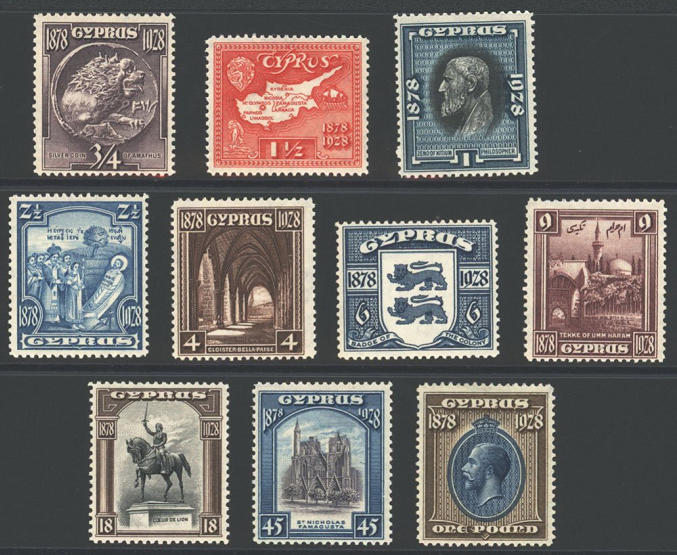In 1928, Cyprus marked the 50th anniversary of British Rule with the release of a remarkable set of commemorative stamps. This iconic collection, featuring 10 distinct designs, beautifully represents Cyprus’s rich historical, cultural, and geographical heritage.
Historical Context
The British formally annexed Cyprus in 1878, marking the beginning of a significant period in the island’s history. By 1928, the 50-year milestone was an occasion to reflect upon this era. The commemorative stamps showcased key symbols and landmarks, encapsulating the diverse influences that shaped Cyprus over centuries.
The Stamp Designs and Their Significance
-
¾ Piastre – Deep Dull Purple (Catalogue Number 14): Featuring the Silver Coin of Amathus from the 6th century BC, symbolizing Cyprus’s ancient economic and cultural heritage.
-
1 Piastre – Black and Greenish Blue (Catalogue Number 15): Depicting Zeno, the philosopher and founder of Stoicism, highlighting Cyprus’s contributions to global philosophy.
-
1½ Piastre – Scarlet (Catalogue Number 16): Showcasing a Map of Cyprus, a patriotic design emphasizing the island’s distinct geography.
-
2½ Piastre – Light Blue (Catalogue Number 17): Illustrating the Discovery of the Body of St. Barnabas, a significant religious event tied to the origins of Christianity in Cyprus.
-
4 Piastre – Deep Brown (Catalogue Number 18): Featuring the Cloister of the Abbey of Bellapais, a medieval architectural marvel that speaks to Cyprus’s rich historical heritage.
-
6 Piastre – Blue (Catalogue Number 19): Depicting the Badge of Cyprus, representing the colonial governance and national identity.
-
9 Piastre – Maroon (Catalogue Number 20): Highlighting the Tekke of Umm Haram, a revered Islamic landmark located near Larnaca.
-
18 Piastre – Black and Brown (Catalogue Number 21): Featuring the Statue of Richard I at Westminster, commemorating the historical Crusader connection when Richard the Lionheart captured Cyprus in 1191.
-
45 Piastre – Violet and Blue (Catalogue Number 22): Illustrating St. Nicholas Cathedral (now Lala Mustafa Pasha Mosque in Famagusta), symbolizing Cyprus’s religious and architectural evolution.
-
£1 – Blue and Bistre-Brown (Catalogue Number 23): Showcasing a portrait of King George V, signifying British sovereignty during this era.
Key Details of the Stamp Issue
- Date of Issue: 1 February 1928

- Watermark: Multi Script CA
- Perforation: 12
- Printing Process: Recess by De La Rue (D.W.)
- Catalogue Numbers: SG 123 to SG 132
Valuation Insights
- The ¾ Pi. deep dull purple stamp is valued at £3.75 mint and £1.50 used.
- The 1 Pi. black and greenish blue stamp holds a value of £4.00 mint and £1.75 used.
- The 1½ Pi. scarlet stamp is valued at £9.50 mint and £2.00 used.
- The 2½ Pi. light blue stamp carries a value of £4.25 mint and £2.50 used.
- The 4 Pi. deep brown stamp is valued at £11.00 mint and £12.00 used.
- The 6 Pi. blue stamp is priced at £16.00 mint and £30.00 used.
- The 9 Pi. maroon stamp holds a value of £11.00 mint and £20.00 used.
- The 18 Pi. black and brown stamp is valued at £30.00 mint and £45.00 used.
- The 45 Pi. violet and blue stamp is priced at £42.00 mint and £60.00 used.
- The highest-value stamp, the £1 blue and bistre-brown featuring King George V, is valued at £225.00 mint and £325.00 used.
- A complete set of 10 stamps is valued at £300 mint and £450 used.
- The Specimen Set (with ‘Specimen’ overprint) is valued at £700, emphasizing its rarity and collector appeal.
Why is this Set Significant?
- Rich Historical Representation: Each stamp tells a story, showcasing the island’s deep cultural and historical roots, from ancient coins to philosophical contributions and key historical figures.
- Exceptional Design: Produced with intricate engraving and vibrant colours, these stamps stand out for their artistic merit.
- High Collector Value: With some stamps, particularly the £1 King George V, commanding high market prices, this set is a prized possession for any collector.
- Cultural Symbolism: This collection is a testament to the island’s diverse religious, architectural, and historical influences, making it a key highlight in British Colonial philately.
Collector’s Insights
- Rarity: The £1 King George V and the 45pi. violet and blue stamps are among the most valuable and sought-after.
- Investment Potential: Given the rising interest in colonial-era stamps, especially with historical significance, this set is considered a good long-term investment.
- Specimen Rarity: Specimen sets are rare and typically more valuable due to their limited issuance for reference purposes.
Conclusion
The 1928 Cyprus 50th Anniversary Stamp Set is more than just a commemorative issue—it’s a historical narrative in miniature form. Every stamp reflects the cultural and historical journey of Cyprus during British rule, from ancient civilizations to colonial governance.
For philatelists and history enthusiasts alike, this set represents an essential chapter in both Cypriot and British postal history, and owning these stamps is akin to preserving a piece of heritage.


